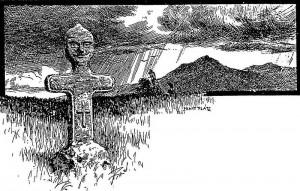
"He proposed that the ceremony be performed by phonograph."
The record player was initially a disappointing technology, but one nineteenth-century Brooklyn undertaker found use for it during an unusual funeral. An excerpt about the odd ceremony from an August 18, 1895 article in the Brooklyn Daily Eagle:
“Undertaker Stillwell of Gravesend has at last achieved his desire and held a funeral with the services conducted by a phonograph. In spite of its novelty there was nothing indecorous about the circumstances and in fact the mourners were visibly affected.
Augusta Burr, a baby of 16 months, who had been posing in a Coney Island museum as a freak, she being the size of a child of 5, and weighing ninety-three pounds, was in perfect health until Monday. She began to suffer from her teeth and then pneumonia set in. Thursday she died.
Mr. Stillwell was given charge of the funeral. As the relatives were non-residents, they desired a modest and speedy funeral, and being poor they wanted it to be cheaply conducted.
This was agreed to, and Mr. Stillwell had the body of the infant taken to his undertaking establishment, on the Neck Road, in the town of Gravesend, Saturday afternoon, when the mother and sister met with others to accompany the body to the Gravesend cemetery, where it was to be interred. The mother expressed a wish that a clergyman might be secured to conduct a burial service over the body of the baby. There was no clergyman to be got handily, and Mr. Stillwell so told her. Her grief at this statement affected him, and then he proposed that the ceremony be performed by phonograph. The mother immediately agreed to it.
Mr. Stillwell is an expert in the management of the phonograph, and placed the records already made in their proper order, as the weeping relatives and friends gathered around the coffin containing the remains of their dear one.
 First the Lord’s Prayer was rendered with a solemn emphasis that took away all the suggestion of mechanical effect. It impressed the mourners. Then a record by the Mozart quartet of the hymn, ‘Nearer My God to Thee,’ was given on another cup and after that the verses of the Scripture usually given at funerals and beginning with the words, ‘Man, who is born of woman,’ etc., were rendered with full emphasis. Then a solo, ‘The Sweet Bye and Bye,’ recorded by Miss Loreen Williamson of Gravesend was repeated. The closing portion was the committal service used by the Reformed Church denomination. The remains were then conveyed to the town cemetery, where they were interred without further ceremonies.
First the Lord’s Prayer was rendered with a solemn emphasis that took away all the suggestion of mechanical effect. It impressed the mourners. Then a record by the Mozart quartet of the hymn, ‘Nearer My God to Thee,’ was given on another cup and after that the verses of the Scripture usually given at funerals and beginning with the words, ‘Man, who is born of woman,’ etc., were rendered with full emphasis. Then a solo, ‘The Sweet Bye and Bye,’ recorded by Miss Loreen Williamson of Gravesend was repeated. The closing portion was the committal service used by the Reformed Church denomination. The remains were then conveyed to the town cemetery, where they were interred without further ceremonies.
Mr. Stillwell, when spoken to on the matter last night, said he was entirely satisfied with the result. He said:
‘It was a solemn, if a novel scene. I confess I felt a degree of trepidation when the service began, but when the inanimate machine, with its whirring accompaniment, began the solemn words, they seemed invested with a feeling of comfort, and touched everyone present.'”



















